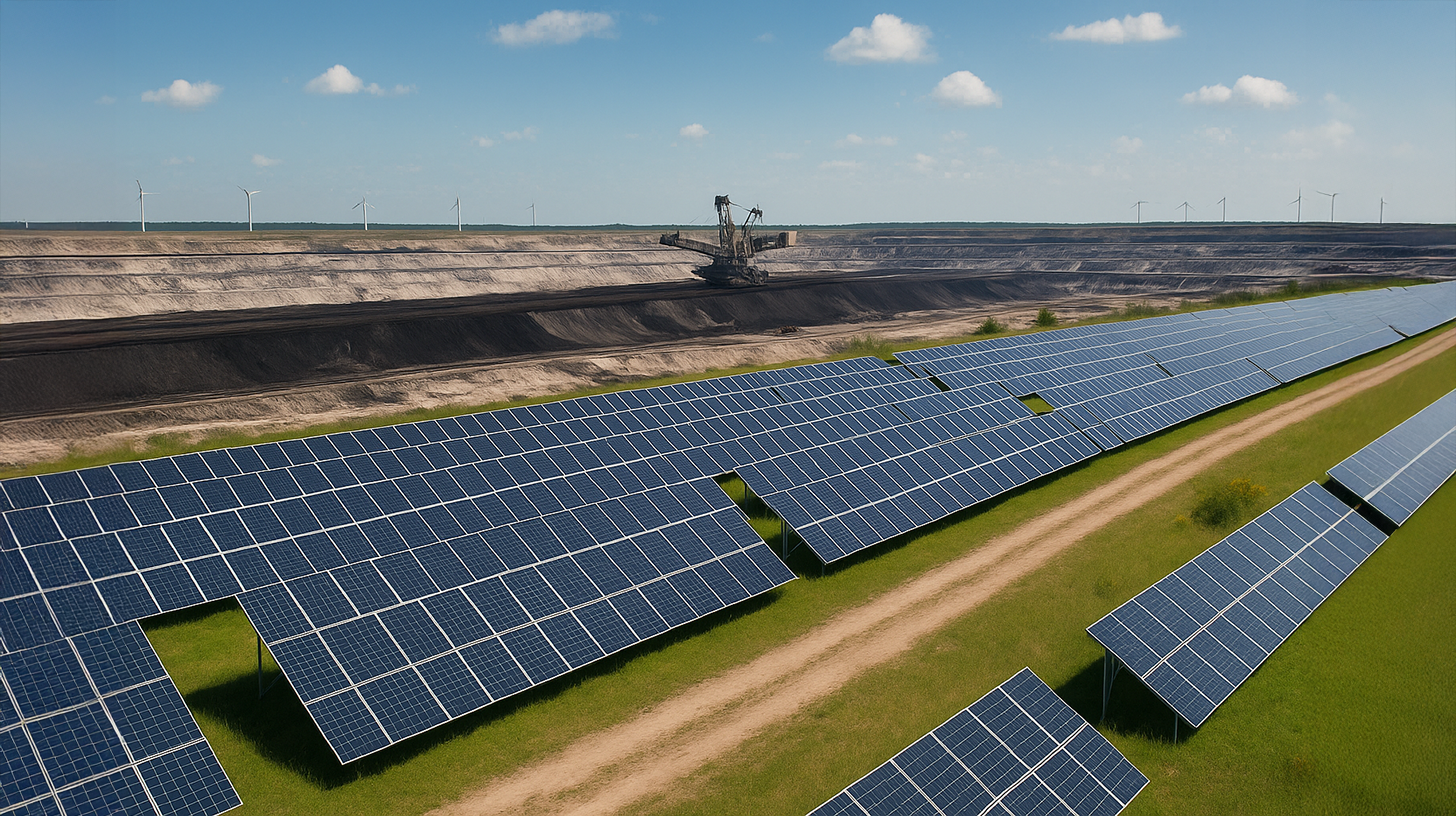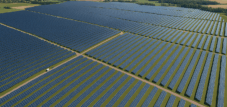
Die Solarpark-Initiative (Park Słoneczny) in Kleszczów: Wegweisende Energiewende in Polens größtem Kohlerevier – Kreativbild: Xpert.Digital
Historischer Wandel in Polen: Erneuerbare Energie überholt die Kohle – und dieses Projekt zeigt, wie
Vom CO2-Giganten zum Solar-Pionier: Diese Gemeinde revolutioniert Polens Energiewende
Die Energielandschaft in Polen erfährt derzeit einen dramatischen Wandel. Mittlerweile überholen erneuerbare Energien die Kohle als wichtigste Stromquelle, nachdem sie im Juni 2025 erstmals 44,1 Prozent des polnischen Strommixes ausmachten, während die Kohle auf 43,7 Prozent zurückfiel. In diesem Kontext der umfassenden Transformation entsteht ein besonders symbolträchtiges Projekt: der 50-Megawatt-Solarpark in der Gemeinde Kleszczów, dem Herzen des polnischen Braunkohlebergbaus.
Eine erfolgreiche Partnerschaft zwischen öffentlichem und privatem Sektor
Der geplante Solarpark in Kleszczów stellt nicht nur eine bedeutende Investition in erneuerbare Energien dar, sondern auch ein bahnbrechendes Modell der öffentlich-privaten Zusammenarbeit. Die Farm entsteht als Joint Venture zwischen PGE Energia Odnawialna, einer Tochtergesellschaft des staatlichen Energiekonzerns PGE Polska Grupa Energetyczna, und der Gemeinde Kleszczów. Beide Partner halten jeweils 50 Prozent der Anteile an der eigens dafür gegründeten Projektgesellschaft PGE Soleo1.
Diese gleichberechtigte Partnerschaft zwischen einem großen Energiekonzern und einer lokalen Gemeinde ist außergewöhnlich und zeigt neue Wege für die Finanzierung und Umsetzung von Solarprojekten auf. Während der Energiekonzern seine technische Expertise und Finanzstärke einbringt, steuert die Gemeinde das benötigte Land bei und profitiert direkt von den Erträgen der Anlage.
Technische Dimensionen und Leistungsdaten
Die Photovoltaikanlage soll auf einer Fläche von 50 Hektar errichtet werden und eine Nennleistung von 50 Megawatt erreichen. Die prognostizierte jährliche Stromproduktion beträgt 53 Gigawattstunden, was ausreicht, um etwa 25.000 polnische Haushalte mit sauberer Energie zu versorgen. Diese Leistungswerte positionieren die Farm als eine der größeren Photovoltaikanlagen in Polen und als wichtigen Baustein der polnischen Energiewende.
Die Anlage wird mit modernsten Photovoltaikmodulen ausgestattet, deren technische Parameter hohe Produktivität auch unter den klimatischen Bedingungen Mittelpolens gewährleisten. Die Wahl der Technologie folgt den neuesten Standards der Branche und berücksichtigt die Anforderungen für eine langfristige und zuverlässige Energieerzeugung über die geplante Betriebsdauer von mindestens 20 Jahren.
Strategische Bedeutung für die regionale Transformation
Die Gemeinde Kleszczów befindet sich in einer besonderen Situation: Auf ihrem Gebiet liegt das Kraftwerk Bełchatów, das größte Braunkohlekraftwerk Europas und gleichzeitig der größte CO2-Emittent der Europäischen Union mit 30 Millionen Tonnen jährlich. Das Kraftwerk produziert rund ein Fünftel des polnischen Strombedarfs und beschäftigt direkt und indirekt Zehntausende von Menschen in der Region.
Die Solarfarm ist ein zentraler Baustein des Programms für eine gerechte Transformation der Region Bełchatów, das PGE als Antwort auf den unvermeidlichen Strukturwandel entwickelt hat. Dieses Programm sieht vor, dass Schritt für Schritt neben der Photovoltaikanlage auch Windenergieprojekte und Energiespeicher in der Region entstehen, um das große Kohlekraftwerk langfristig zu ersetzen.
Für die Gemeinde Kleszczów, die bisher als reichste Gemeinde Polens galt und ihre hohen Steuereinnahmen hauptsächlich dem Kraftwerk verdankte, bedeutet der Wandel sowohl Herausforderung als auch Chance. Der Solarpark wird zusätzliche Einnahmen durch Grundsteuern, Pachtgebühren und Gewinnbeteiligungen generieren, die helfen, den zu erwartenden Rückgang der Einnahmen aus dem Kohlekraftwerk teilweise zu kompensieren.
Finanzierung und Vermarktung der Solarenergie
Die Finanzierung und Vermarktung der Anlage folgt einem flexiblen Ansatz. PGE und die Gemeinde haben sich darauf verständigt, die Energie entweder über das polnische Auktionssystem für erneuerbare Energien oder über langfristige Direktverkaufsverträge, sogenannte Power Purchase Agreements, zu vermarkten. Diese Flexibilität ermöglicht es, je nach Marktlage die wirtschaftlich optimale Vermarktungsstrategie zu wählen.
Das polnische Auktionssystem hat sich als effektives Instrument zur Förderung erneuerbarer Energien etabliert und bietet planbare Einnahmen über lange Zeiträume. Alternativ können PPAs direktere Kundenbeziehungen ermöglichen und möglicherweise bessere Preise erzielen, erfordern aber auch ein aktiveres Vermarktungsmanagement.
Integration in die nationale Photovoltaik-Strategie
Das Projekt fügt sich nahtlos in die ehrgeizigen Ausbaupläne von PGE für Solarenergie ein. Der Konzern plant bis 2030 ein Portfolio von über 3 Gigawatt an Photovoltaikkapazität aufzubauen und damit seine Position als führender Produzent erneuerbarer Energien in Polen zu festigen. Bereits 2024 hat PGE Energia Odnawialna 180,4 Megawatt neue Solarkapazität in Betrieb genommen und will 2025 weitere 140 Megawatt hinzufügen.
Die Farm in Kleszczów ist dabei eines der Flaggschiffprojekte und zeigt, wie PGE sowohl technisch als auch organisatorisch neue Wege bei der Entwicklung von Solarprojekten beschreitet. Die Kooperation mit der Gemeinde als gleichberechtigtem Partner könnte als Modell für weitere Projekte dienen und die lokale Akzeptanz für Energieinfrastruktur stärken.
Polen als aufstrebender Solarmarkt
Polen hat sich in den vergangenen Jahren zu einem der dynamischsten Photovoltaikmärkte Europas entwickelt. 2020 wurden Solaranlagen mit einer Gesamtleistung von 2,2 Gigawatt installiert, was einer Verdoppelung gegenüber dem Vorjahr entspricht und Polen zum viertgrößten Solarmarkt Europas nach Spanien, den Niederlanden und Deutschland macht.
Das Wachstum findet auf allen Ebenen statt: von kleinen Dachanlagen mit durchschnittlich 6,5 Kilowatt Leistung, deren Zahl von 155.000 Ende 2019 auf 350.000 Ende 2020 stieg, bis hin zu großen Freiflächenanlagen wie dem geplanten 303-Megawatt-Solarpark der VSB Gruppe in Niederschlesien. Die polnische Energieregulierungsbehörde hat für größere Projekte bereits vorläufige Netzanschlussgenehmigungen im Umfang von 4,4 Gigawatt erteilt.
Neu: Patent aus den USA – Solarparks bis zu 30 % günstiger und 40 % schneller und einfacher installieren – mit Erklärvideos!
Neu: Patent aus den USA – Solarparks bis zu 30 % günstiger und 40 % schneller und einfacher installieren – mit Erklärvideos! - Bild: Xpert.Digital
Das Herzstück dieser technologischen Weiterentwicklung ist die bewusste Abkehr von der konventionellen Klemmenbefestigung, die seit Jahrzehnten den Standard darstellt. Das neue und zeit- wie kostengünstigere Montagesystem begegnet dieses mit einem grundlegend anderen, intelligenteren Konzept. Anstatt die Module punktuell zu klemmen, werden sie in eine durchgehende, speziell geformte Trägerschiene eingelegt und dort sicher gehalten. Diese Konstruktion sorgt dafür, dass alle auftretenden Kräfte – seien es statische Lasten durch Schnee oder dynamische Lasten durch Wind – gleichmäßig über die gesamte Länge des Modulrahmens verteilt werden.
Mehr dazu hier:
Solarparks statt Kohlekraftwerke: Polens smarte Antwort auf den Klimawandel
Herausforderungen der Energiewende in einem Kohleland
Polen steht vor der enormen Herausforderung, sein stark von Kohle abhängiges Energiesystem zu transformieren. Noch 2023 stammten etwa 57 Prozent des Stroms aus Kohle, doch dieser Anteil sinkt stetig. Die Regierung unter Ministerpräsident Donald Tusk hat das ehrgeizige Ziel ausgegeben, die CO2-Emissionen bis 2030 um 75 Prozent zu senken.
Experten wie der Rat für Energiesicherheit und Klima fordern sogar einen kompletten Ausstieg aus der Kohleverstromung bis 2035 und damit früher als Deutschland mit seinem Ausstiegsdatum 2038. Dies würde bedeuten, dass auch das Kraftwerk Bełchatów, das derzeit noch über 20 Prozent des polnischen Stroms produziert, in den kommenden zehn Jahren stillgelegt werden müsste.
Die Transformation wird durch die wirtschaftlichen Realitäten beschleunigt: Das Durchschnittsalter der polnischen Kohlekraftwerke beträgt 37 Jahre, viele Anlagen sind ineffizient und fallen häufiger aus. Gleichzeitig sind die Förderkosten für Steinkohle auf 824 Zloty pro Tonne gestiegen, während der Weltmarktpreis nur bei etwa 110 Euro liegt.
Soziale Aspekte und Arbeitsplätze
Der Strukturwandel betrifft direkt etwa 75.000 Bergleute in Polen, deren Arbeitsplätze durch die Energiewende gefährdet sind. Die polnische Regierung plant daher für 2025 Subventionen von neun Milliarden Zloty für den Kohlebergbau, um soziale Spannungen zu vermeiden und Zeit für den Übergang zu schaffen.
Das Solarpark-Projekt in Kleszczów zeigt, wie dieser Übergang gelingen kann: Neue Technologien schaffen neue Arbeitsplätze, auch wenn diese oft andere Qualifikationen erfordern. PGE hat bereits ein Zentrum für Kompetenzentwicklung eröffnet, das Arbeitskräfte für die neuen Anforderungen der Energiewirtschaft qualifiziert.
Umwelt- und Gesundheitsaspekte
Die gesundheitlichen Auswirkungen der Kohleverstromung sind in der Region Bełchatów besonders spürbar. Mediziner bestätigen, dass die Luftverschmutzung durch das Kraftwerk die Lebenserwartung der Menschen in der Region verkürzt und die Zahl der Herzinfarkte und Schlaganfälle erhöht. Der Feinstaub verbreitet sich über viele Kilometer und belastet eine große Region.
Der Solarpark wird dazu beitragen, diese Belastungen zu reduzieren. Jede Kilowattstunde Solarstrom ersetzt potenziell Kohlestrom und vermeidet damit CO2-Emissionen und andere Schadstoffe. Bei der prognostizierten Jahresproduktion von 53 Gigawattstunden können erhebliche Mengen an Emissionen eingespart werden.
Technologische Innovationen und Effizienz
Moderne Solarparks wie der in Kleszczów geplante setzen auf die neuesten Entwicklungen der Photovoltaiktechnologie. Dazu gehören bifaziale Module, die Licht von beiden Seiten aufnehmen und damit höhere Erträge erzielen, sowie optimierte Wechselrichtertechnologie für maximale Systemeffizienz.
Die Standortwahl berücksichtigt nicht nur die Verfügbarkeit geeigneter Flächen, sondern auch die lokalen Sonnenscheinverhältnisse, die Anbindung an das Stromnetz und die Bodenbeschaffenheit. In Polen liegt die durchschnittliche Sonneneinstrahlung bei etwa 1000 bis 1200 Kilowattstunden pro Quadratmeter und Jahr, was durchaus wirtschaftliche Solarstromerzeugung ermöglicht.
Netzintegration und Systemstabilität
Die Integration großer Solarparks in das polnische Stromnetz erfordert sorgfältige Planung und entsprechende Netzinfrastruktur. Polen investiert daher massiv in die Modernisierung und den Ausbau seiner Übertragungsnetze, um die schwankende Einspeisung erneuerbarer Energien zu bewältigen.
Der Standort Kleszczów bietet den Vorteil einer bereits vorhandenen leistungsstarken Netzanbindung durch das Kraftwerk Bełchatów. Diese Infrastruktur kann teilweise für die Einspeisung des Solarstroms genutzt werden, was Kosten spart und die Integration erleichtert.
Internationale Einordnung und Vergleich
Mit einer Leistung von 50 Megawatt gehört der geplante Solarpark zu den größeren Anlagen in Polen, liegt aber noch deutlich unter den Dimensionen der weltweit größten Solarparks mit 2000 bis 2200 Megawatt. In Deutschland entspricht die Größe etwa mittleren bis größeren Freiflächenanlagen, wie sie durch das Erneuerbare-Energien-Gesetz gefördert werden.
Im europäischen Vergleich zeigt das Projekt, wie auch traditionelle Kohleländer den Übergang zu erneuerbaren Energien schaffen können. Ähnliche Transformationsprojekte gibt es in der deutschen Lausitz, wo auf ehemaligen Braunkohletagebauflächen große Solarparks entstehen.
Zeitplan und Realisierung
Die ursprünglichen Planungen sahen eine Inbetriebnahme bis Ende 2022 vor. Nach aktuellen Informationen wird die Fertigstellung nun für 2026 erwartet, was den typischen Entwicklungszeiten für Solarprojekte dieser Größenordnung entspricht. Die Verzögerung kann auf die Komplexität des Joint-Venture-Modells, Genehmigungsverfahren oder Lieferkettenschwierigkeiten zurückzuführen sein.
Der Baubeginn wird voraussichtlich 2025 erfolgen, nachdem alle erforderlichen Genehmigungen vorliegen und die Finanzierung gesichert ist. Die Bauzeit für einen 50-Megawatt-Solarpark beträgt typischerweise sechs bis zwölf Monate, je nach Bodenverhältnissen und Witterung.
Wirtschaftliche Auswirkungen auf die Region
Der Solarpark wird nicht nur während der Bauphase Arbeitsplätze schaffen, sondern auch langfristige wirtschaftliche Impulse für die Region setzen. Die lokalen Zulieferer und Dienstleister profitieren von den Aufträgen, und die Gemeinde erhält dauerhafte zusätzliche Einnahmen.
PGE hat zugesagt, bei der Auftragsvergabe lokale Unternehmen zu bevorzugen, soweit dies möglich ist. Dies entspricht der Strategie des Konzerns, durch “Local Content” die regionale Wertschöpfung zu stärken und die Akzeptanz für Energieprojekte zu erhöhen.
Solarparks als Zukunftsmodell: Polens strategische Energiewende
Der Solarpark in Kleszczów ist nur der Anfang einer umfassenden Transformation der Region. PGE plant weitere erneuerbare Energieprojekte, darunter Windparks und Energiespeicher, um ein vollständiges Portfolio aufzubauen. Bis 2035 soll die gesamte Gruppe klimaneutral werden und 235 Milliarden Zloty in den Umbau des Energiesystems investieren.
Das Joint-Venture-Modell könnte Schule machen und auch in anderen Regionen Polens zur Anwendung kommen. Die gleichberechtigte Partnerschaft zwischen Energiekonzernen und Gemeinden kann die lokale Akzeptanz für Energieprojekte erhöhen und faire Teilhabe an den Erträgen sicherstellen.
Der Erfolg des Projekts wird nicht nur an der technischen Realisierung und wirtschaftlichen Performance gemessen, sondern auch daran, wie gut es gelingt, die betroffenen Menschen und Gemeinden in den Transformationsprozess einzubeziehen und neue Perspektiven für die Zeit nach der Kohle zu schaffen. In diesem Sinne ist der Solarpark Kleszczów mehr als nur eine weitere Photovoltaikanlage – er ist ein Symbol für den Wandel Polens hin zu einer nachhaltigen Energiezukunft.
Schau mal, dieses kleine Detail erspart bis zu 40% Installationszeit und verursacht bis zu 30% weniger Kosten. Kommt aus den USA, ist patentiert.
Das Herzstück der Innovation von ModuRack ist die Abkehr von der konventionellen Klemmenbefestigung. Anstelle von Klemmen werden die Module in eine durchgehende Trägerschiene eingelegt und gehalten.
Mehr dazu hier:
Ihr Partner für Business Development im Bereich Photovoltaik und Bau
Von Industriedach-PV über Solarparks bis hin zu größeren Solarparkplätzen
☑️ Unsere Geschäftssprache ist Englisch oder Deutsch
☑️ NEU: Schriftverkehr in Ihrer Landessprache!
Gerne stehe ich Ihnen und mein Team als persönlicher Berater zur Verfügung.
Sie können mit mir Kontakt aufnehmen, indem Sie hier das Kontaktformular ausfüllen oder rufen Sie mich einfach unter +49 89 89 674 804 (München) an. Meine E-Mail Adresse lautet: wolfenstein∂xpert.digital
Ich freue mich auf unser gemeinsames Projekt.

